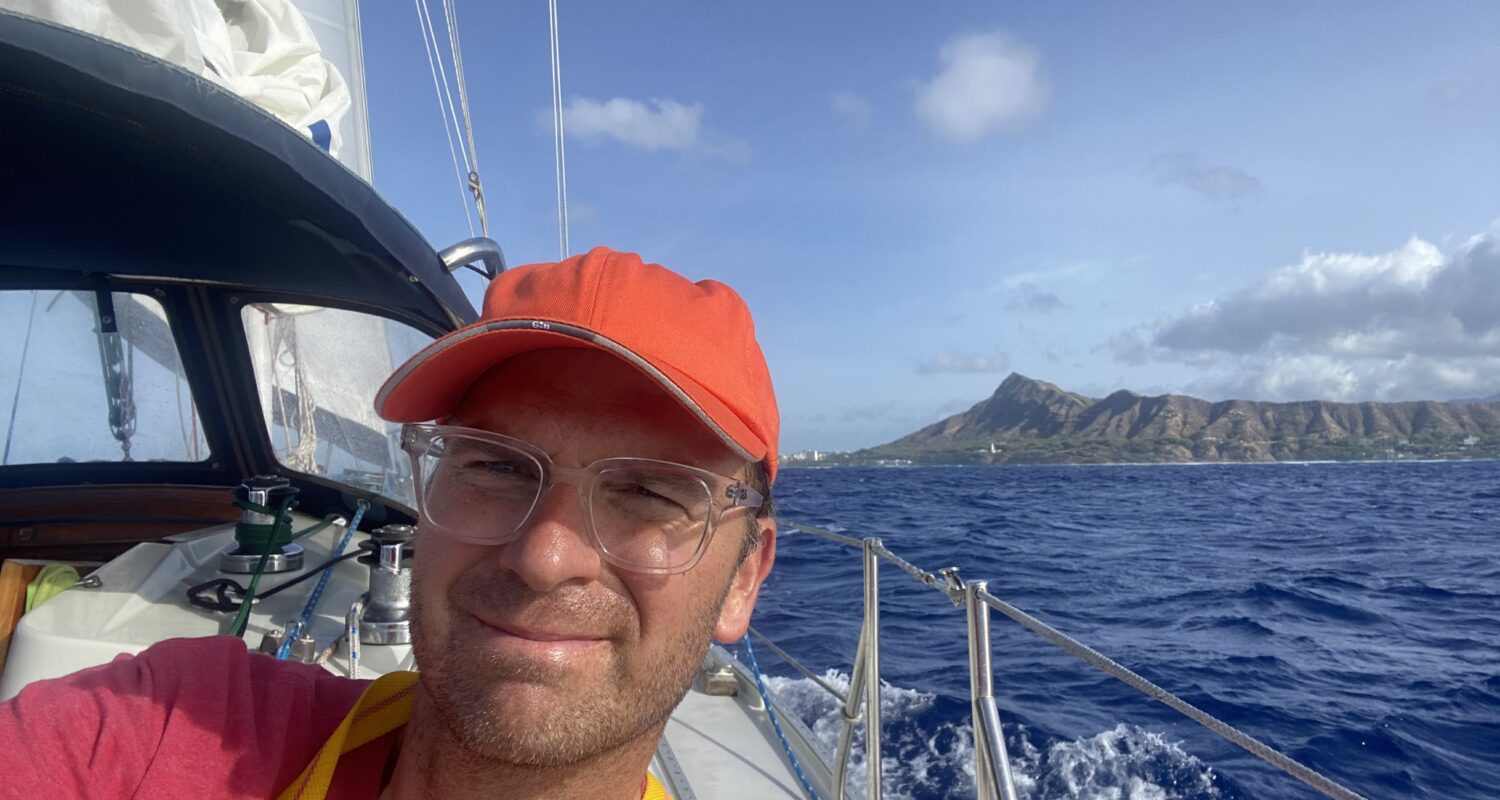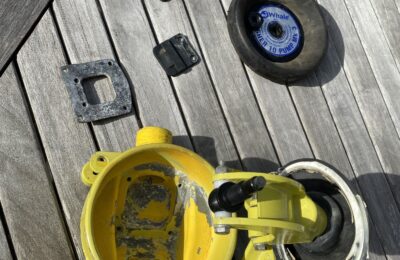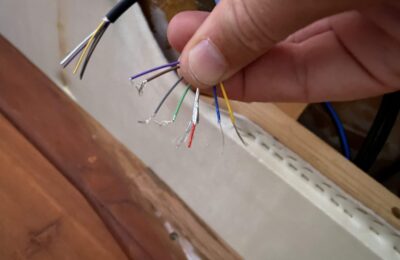Some rough-hewn “technical” notes on my trip. I hope to write some more lyrical narrative versions eventually:
The Jib
The jib sail, the marvelous jib sail! Sure Shot at present carries a high cut “100%” jib, specified primarily for the close-quarters high winds of the San Francisco bay. On my trip, the sail worked wonderfully and I never needed or wanted a larger sail. I had expected a journey with a little less than a week on a beam reach (wind perpendicular to the boat), exiting the Coastal wind flow, and then as I made progress southwest into the tradewinds, the wind would swing around behind me and push me directly downwind.
I had the first near-week of beam-reach winds, but for a majority of the second half of the trip, I found myself on a deep broad reach (apparent wind angle 120-160). At this point having much mainsail up at all would force the boat to round up (point higher up into the wind) away from my intended bearing. I could use my third reef and possibly add some speed, but doing so also shadows part of the jib. So, finding myself deciding between jib-alone at 4.5 knots, or less jib and a reefed main at 4.8-5 kts, I frequently just tied the main off and let the jib do the work.
I am sure the main will be more important for the trip back to California for my delivery team.
Aries Windvane
I have never read a sailor’s negative account of a mechanical windvane and I will fall in line readily. I took great care in installing my vane carefully and securely to the rear of the bosat and I was rewarded for doing so. It steered well in nearly all conditions and had it broken, I would have been tremendously slowed down and stressed out.
The point of sail that typically presents the greatest challenge for a servo-pendulum wind vane is dead down wind in swell. The reasons are that for the wind blade to work, the blade needs to be in something like 8 knots or more of apparent wind. If your boat is traveling downwind at 5 knots, that means you need a tailwind of 13 (minus the five for your direction of travel) to yield 8 knots of apparent wind. The wind blade then rotates an oar in the water which swings to pull the helm to one side or the other.
In a following-sea swell, the boat is constantly being lifted up and then lowered back down by the waves that approach from the rear and then move past the craft. Carrying five and a half or six knots is in practice sitting in a sine curve of the boat accelerating to 7 knots down the faces of the waves and then decelerating to 4.5 knots as the bow settles into the trough. This oscillation of speed confounds the operation of the wind vane somewhat. The steering oar doesn’t face a constant speed and the result is a path of travel of exaggerated S-turns rather than a steady line.
To sum up, the larger the waves are, the more wind is required to keep a vane happy dead down wind.
The wave-related pulsating-speed-in-lighter-winds problem also affects the sails more if one is rigged Wing-On-Wing. The boat can overrun the wind (popping the guyed-sails backwards) down the face of the wave, and then have them pop forward as the boat slows and then wind fills them back up. If that is difficult to understand, picture a classroom of kids encircling a parachute, pulling it up and down like a trampoline. Poof up! Poof down. Not good for steady-as-she-goes passagemaking.
Lee Cloths
I sewed the Sailrite patterned lee cloths before I left and I am glad that I did. The general idea is a lee cloth serves as fabric wall that keeps a sleeping person from rolling out of bed while the boat moves around. For this purpose they worked fine. The unexpected benefit was that I could leave the windward (upwind) cloth up, and then I had a huge fabric basket-place to throw gear that I needed to keep handy and quiet. Harness, tether, rain jacket, hat, pillow, sleeping bag. They could all slump into the other bunk like a gear hammock and not slide around and not make noise. There is so much traipsing up on deck for which the harness and tether are required. Put it on. Take it off. Put it on… ad infinitum. Chuck them in the up-wind bunk and they are handy and accessible.
Books and Podcasts
In normal life on shore, my reading is focused primarily on world and financial news websites. I took a morning to check out a variety of books from my local public library and also had a kindle with some unread titles. I also downloaded what I thought was an over-abundance of podcasts. It was enormously valuable to have taken this time to give myself mental material to process. In terms of trip preparation I have spent an enormous amount of time and energy on the boat itself, and my skills. I did not spend a great deal of time strategizing about what I would be doing with my time on board. In practice, the answer to, “What’s Tom doing on the boat?” would in a majority of cases be, “Sweating a little, balanced somewhat precariously in his bunk, reading a novel or listening to a podcast.”
Personal Well-Being
For context, prior to this trip, I have had very limited experience living on/traveling by sailboat (or any boat for that matter). I took an overnight trip by myself down the coast to Monterey from San Francisco. On that trip my cooking accomplishment was that I made a cup of coffee under way. I did an anchored-out overnight with two other people that was good practice and a couple of safe harbor overnights also. But really very limited experience.
I expected to be seasick for a few days and then for my body to normalize. That is what I experienced for the most part. What has happened in the past is that seasickness leads to dehydration, which leads to lethargy. That all happened on the trip, plus a loss of appetite. The loss of appetite leads to low energy and a reduced ability to get things done. This is an issue for a solo sailor as there is of course no one else there to pick up the slack.
It was a struggle to stay hydrated. I didn’t feel like drinking water – it was a lukewarm struggle. I knew I had to in order to keep energy going and to get my body normalized, but it was still a struggle.
I did not bring any alcohol on the trip. If there were going to be any problems, I didn’t want that to be an explanation for myself or others for user error.
At home I am a prolific drinker of coffee. While I brought plenty on the trip, I was only interested in a morning cup on about a third of the days. Being without alcohol and for the most part, caffeine left me in a sort of steady, if slightly dulled state. That’s probably a good description of the middle part of the trip – steady, if slightly dulled.
Technology
The Raymarine equipment I installed last year worked flawlessly (excepting the cantankerous wheel pilot). The SeatalkNG/NMEA2000 network all interlinked as intended.
Navigation was trivial. Before departing Sausalito, I doinked a finger on the Axiom helm computer screen to mark a waypoint just south of Diamond Head off Oahu and clickeds “Go To”. The system instantly inferred a “Distance to Waypoint” (2089 nautical miles) and a “Bearing To Waypoint” of 253 degrees. 270 degrees on the compass is of course directly West, and 180 degrees is directly South. With those inputs, I trimmed the sails to a bearing of 253 degrees, engaged the wind vane, and went below decks to hide from the elements.
My AIS system also worked as intended. I set alarm boundaries such that if in the middle of the night another AIS target was within a few nautical miles of my boat an alarm would sound. I have installed a bonus very loud alarm as part of my network and the sound is deafening. I believe there were three occasions on which the AIS awakened me in the blackness of the ocean at night. Once 500 miles off of Los Angeles, and then again a couple of times about the same distance from Honolulu. I saw no other ships for the middle 1000 miles of the trip.
Regular communications via my Iridium Go modem were good. I called home every day at noon to check in. The sound quality of the calls was adequate though much worse than the 5G performance you expect from your mobile phone on a terrestrial network. There is a half-second gap between the spoken work and the heard message, which not surprisingly, tends to slow conversations. I set the modem out on the helmsman’s seat for reception, and did not use an external antenna.
The PredictWind weather software and app I used for weather routing is designed to be paired with an Iridium Go, and it worked slowly but effectively. I could periodically download a snapshot of a very large area of ocean to see if any hurricanes were coming to get me. Then in a separate download I could drill down on a much smaller area of the ocean and download a series of future predictions to help me know what to expect in tactical terms (what sails I should set at bedtime, for example).
I was using a Garmin InReach Mini as a tracking device. It reports its own position every few minutes via satellite and this is good as a passive solution. The problem is if one forgets (as I did) to recharge the unit in a timely fashion and the device dies. My wife and several friends noticed that I had dropped off the face of the map. It caused concern at home. An alternative is to proactively send updates with position information, though this affirmative action is what I was doing with my daily phone calls.
Food
I quickly came to appreciate the fresh food I had brought. My boat has a built-in cooler that I stocked with ice before departing. I brought bell peppers and cucumbers and carrots that I kept cold as long as possible. I brought a couple of bags of salad and ate those before they went bad. The best performing vegetables were the cucumbers, which lasted the entire trip without turning too mushy.
Oranges! I brought oranges and they held up well. Aerated bags, never became moldy. Sticky fingers, sweet with sugary juice. Delicious pulp.
Canned food has a ridiculous amount of sodium! In my often-dehydrated state, I became increasingly disgusted by the salty quality of the soups and products that I had along. Blech.
Were I to do it again, I would buy a small electric fridge/cooler and wire and lash it in somewhere. The fresh vegetables were key and missed when they dwindled.
Power Supply
I installed a lithium battery system before departing, supported by a fancy upgraded alternator that could produce plenty of amps, and a simple two-panel solar system. My electrical needs were limited and on days where the sails did not block the solar panels, I could run the boat without alternator charging. By the end of the afternoon my primary 50amp hour battery would be 93% charged. Then overnight running radio, electronics and lights @ 2.5 amps 10 hours, I would be down to 25% charged. Flip off the lights at dawn and by 10am or so get to flat energy draw (solar panels push offsetting radio and instrument pull) and by noon, gaining 3-4 positive amps. So a few days where
Engine
To the degree I had any problems with my Yanmar 3 cylinder, they all related to air getting into the fuel lines. I had to bleed some air a couple of times early in the trip, and then once (traumatically) right at the end, within sight of Diamond Head. I encountered big waves (2.5 meters) and fresh winds (25-30 knots) simultaneously and I believe this jostling carbonated the fuel in my tank, which caused the engine to gasp and sputter out as I was turning the corner at Diamond Head, with big breakers and coral reefs and tourist boats in sight. “Go get on the deal team, Vilhauer. No one else is here to solve your problems for you….”
With my solar panels, I only used about 11 gallons of diesel of the 35 gallons I had along. The vast majority of the consumption was for morning battery-charging sessions. I use about 0.7 gallons per hour at 2500rpm and I could normally achieve 85% state of charge in my lithium primary battery within 40 minutes.
User Error
The potentially worst situation in which I found myself was (surprise!) something I could have easily avoided. At some point past midnight on the morning of June 24th, the wind shifted from an Easterly direction to the South. I awoke and took stock of my bearing and intended destination and knew I needed to address the sail trim and course. The swell made a sea-dog’s sails-alone turn inconvenient, and after all I am not a sea dog. I am a modern gentleman, so I decided to take the easy way out of firing up my engine, putting some horses into her, and turning the boat like a Buick.
It was still dark. I let the engine warm up at slow RPM for a couple of minutes and then shifted into forward gear. In about a second, the engine froze. It did not sputter or cough. It froze. I tried to start it again and no dice. I tried to shift back into neutral, but the transmission was frozen. I surmised that there may have been something wrapped around the prop shaft. Sure enough, after reviewing the contents of my cockpit, I realized that my jib furling line was missing. I clipped into my safety gear and walked up the side deck seeing the absence of the line in every spot where it was supposed to be. Sure enough, when I reached the furler on the bow of the boat, I found the line pulled taut directly under the boat.
I had neglected to cleat off the furling line, and to tie a stopper knot in the end of it, so the rope probably was slackened enough to dip into the water near the front end of the boat, at which point the rest of the line was pulled forward and into the water and trailed underneath the centerline of the boat, perfectly placed to seize in the propeller.
What does one do, 500 miles from land, in 16,000 feet of water with a rope-wrapped propeller shaft? I lead cub scouts and the principle we teach the kids is that, when lost one should S.T.O.P, or stop, think, observe, plan. I waited until daylight. I contrived a sea anchor to slow the boat down. I dropped all of the sails. I threw on my goggles I set some backup rescue lines to trail behind the boat. I set a couple of entry points to allow me to get back on the boat. Then I jumped in the ocean.
It was exactly as I had anticipated – the furling line was wrapped around the prop shaft. The boat itself was still jacking around in the waves, and it would have been bad if I had gotten hit with the prop or the strut, but it all worked out just fine. I unwrapped the line and got back on board with a minor amount of effort.
Then commenced another 1-2 hours of work lowering the jib, resetting the furler, and re-hoisting. It all worked out, but was the most pointed example of a small user error spiraling into getting-off-the-boat-alone-in-the-middle-of-the-ocean, something I had no intention of doing at the start of the trip. Yet, with singlehanding, there is no one coming to solve the problem for you.
Weather
I was dealt a good hand with weather. Days 3 and 4 getting off the coast of California were a bit challenging, but for the most part, I had wind between 10 and 20 knots, blowing approximately in the right direction. One could not ask for much more. I was becalmed for a 36-48 hour period, but that bifurcated the trip nicely. After two weeks my impression was that the ocean was relentless. After blowing for weeks, the prospect of an indifferent barometer and still air was even more striking. The calm air was, fortunately, a relatively short chapter, and I still closed out the passage in 20 days.



